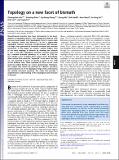| dc.contributor.author | Ma, Qiong | |
| dc.contributor.author | Xu, Su-Yang | |
| dc.contributor.author | Fu, Liang | |
| dc.date.accessioned | 2020-04-01T12:38:22Z | |
| dc.date.available | 2020-04-01T12:38:22Z | |
| dc.date.issued | 2019-06-13 | |
| dc.identifier.issn | 0027-8424 | |
| dc.identifier.issn | 1091-6490 | |
| dc.identifier.uri | https://hdl.handle.net/1721.1/124469 | |
| dc.description.abstract | Bismuth-based materials have been instrumental in the development of topological physics, even though bulk bismuth itself has been long thought to be topologically trivial. A recent study has, however, shown that bismuth is in fact a higher-order topological insulator featuring one-dimensional (1D) topological hinge states protected by threefold rotational and inversion symmetries. In this paper, we uncover another hidden facet of the band topology of bismuth by showing that bismuth is also a first-order topological crystalline insulator protected by a twofold rotational symmetry. As a result, its (110) ¯ surface exhibits a pair of gapless Dirac surface states. Remarkably, these surface Dirac cones are “unpinned” in the sense that they are not restricted to locate at specific k points in the (110) ¯ surface Brillouin zone. These unpinned 2D Dirac surface states could be probed directly via various spectroscopic techniques. Our analysis also reveals the presence of a distinct, previously uncharacterized set of 1D topological hinge states protected by the twofold rotational symmetry. Our study thus provides a comprehensive understanding of the topological band structure of bismuth. | en_US |
| dc.description.sponsorship | China. Ministry of Science and Technology (Grant MOST107-2627-E-006-001) | en_US |
| dc.description.sponsorship | United States. Department of Energy. Division of Materials Sciences and Engineering (Award DE-SC0018945) | en_US |
| dc.description.sponsorship | United States. Department of Energy. Office of Basic Energy Science (ES Grant DE-FG02-07ER46352) | en_US |
| dc.description.sponsorship | United States. Department of Energy (GrantDE-AC02-05CH11231) | en_US |
| dc.description.sponsorship | National Science Foundation (U.S.) (Grant DMR-1231319) | en_US |
| dc.language.iso | en | |
| dc.publisher | Proceedings of the National Academy of Sciences | en_US |
| dc.relation.isversionof | 10.1073/pnas.1900527116 | en_US |
| dc.rights | Article is made available in accordance with the publisher's policy and may be subject to US copyright law. Please refer to the publisher's site for terms of use. | en_US |
| dc.source | PNAS | en_US |
| dc.subject | Multidisciplinary | en_US |
| dc.title | Topology on a new facet of bismuth | en_US |
| dc.type | Article | en_US |
| dc.identifier.citation | Hsu, Chuang-Han et al. "Topology on a new facet of bismuth." Proceedings of the National Academy of Sciences of the United States of America 116 (2019): 13255-13259 © 2019 The Author(s) | en_US |
| dc.contributor.department | Massachusetts Institute of Technology. Department of Physics | en_US |
| dc.relation.journal | Proceedings of the National Academy of Sciences of the United States of America | en_US |
| dc.eprint.version | Final published version | en_US |
| dc.type.uri | http://purl.org/eprint/type/JournalArticle | en_US |
| eprint.status | http://purl.org/eprint/status/PeerReviewed | en_US |
| dc.date.updated | 2020-02-13T13:27:29Z | |
| dspace.date.submission | 2020-02-13T13:27:31Z | |
| mit.journal.volume | 116 | en_US |
| mit.journal.issue | 27 | en_US |
| mit.license | PUBLISHER_POLICY | |
| mit.metadata.status | Complete | |
